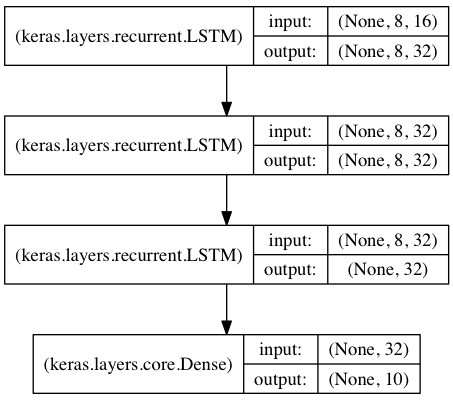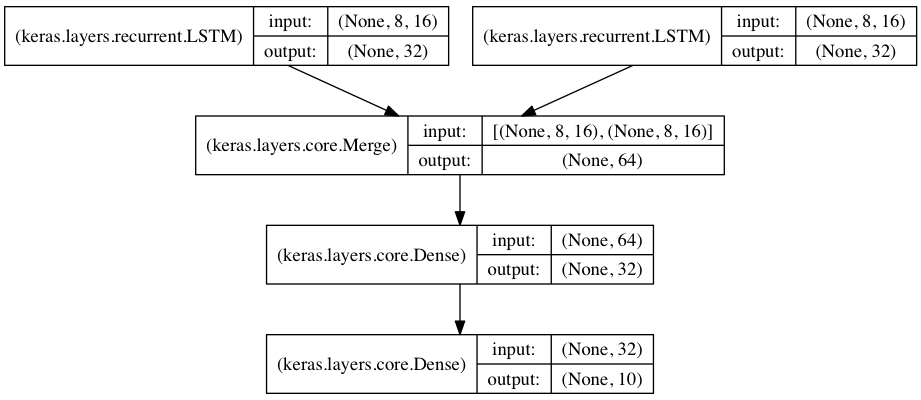版权声明:本文为博主原创文章,未经博主允许不得转载。 https://blog.csdn.net/Thinking\_boy1992/article/details/53207177
本文翻译自
时序模型就是层次的线性叠加。
你能够通过向构造函数传递层实例的列表构建序列模型:
from keras.models import Sequential
from keras.layers import Dense, Activation
model = Sequential([
Dense(32, input_dim=784),
Activation('relu'),
Dense(10),
Activation('softmax'),
])
也可以简单的通过.add()添加层:
model = Sequential()
model.add(Dense(32, input_dim=784))
model.add(Activation('relu'))
指定输入形状(Specifying the input shape)
模型需要知道输入的形状。正因为如此,序列模型的第一层(只有第一层,下面的层次能自动进行形状推测)需要接受有关输入形状的信息。这里有几种方式来做这些:
通过第一层的一个参数input_shape进行传递。这是一个形状元组(整数元组或None条目,None指示任何可能的整数都可以)。在Input_shape ,批维度没有被包含;
传进batch_input_shape 参数,它包含了批维度;制定一个固定的批大小是有用的;
一些2D层,例如Dense,支持通过参数input_dim指定输入的形状,一些3D时间层支持参数input_dim或input_length
正因为如此,以下三个代码片段完全相同:
model = Sequential()
model.add(Dense(32, input_shape=(784,)))
model = Sequential()
model.add(Dense(32, batch_input_shape=(None, 784)))
# note that batch dimension is "None" here,
# so the model will be able to process batches of any size.
model = Sequential()
model.add(Dense(32, input_dim=784))
下面的三个片段同样相同:
model = Sequential()
model.add(LSTM(32, input_shape=(10, 64)))
model = Sequential()
model.add(LSTM(32, batch_input_shape=(None, 10, 64)))
model = Sequential()
model.add(LSTM(32, input_length=10, input_dim=64))
合并层(The Merge layer)
多个Sequential 实例能够通过Merge层合并为单个的输出;
输出能够在一个新的Sequential模型中像第一层那样进行添加;例如,下面的模型把两个分离的输入分支进行整合;
from keras.layers import Merge
left_branch = Sequential()
left_branch.add(Dense(32, input_dim=784))
right_branch = Sequential()
right_branch.add(Dense(32, input_dim=784))
merged = Merge([left_branch, right_branch], mode='concat')
final_model = Sequential()
final_model.add(merged)
final_model.add(Dense(10, activation='softmax'))
如此的一个两分支模型能够被训练:
final_model.compile(optimizer='rmsprop', loss='categorical_crossentropy')
final_model.fit([input_data_1, input_data_2], targets) # we pass one data array per model input
合并层支持一些预定义的模式:
sum(default):元素的总和;
concat:向量级联,可以通过concat_axis设置级联轴;
mul:元素相乘
ave:向量平均;
dot:点积;能够通过dot_axes参数指定轴进行减少;
cos:向量间的余弦距离;
还可以通过允许任意变换的函数作为mode参数进行传递;
merged = Merge([left_branch, right_branch], mode=lambda x: x[0] - x[1])
现在已经能够使用Keras来定义任何的模型。对于不能通过Sequential和Merge进行表示的复杂模型。能够使用 the functional API
编译(Compilation)
在训练一个模型之前,需要配置它的学习过程,这是通过compile函数来做的。它接受三个参数:
一个优化器:它可以是现有的优化器的字符串标识符(例如 rmsprop or adagrad),也可以是优化器类的实例;有关优化器
一个损失函数:这是模型想要最小化的目标函数,它可以是一个现存的损失函数的字符串标识符(such as categorical_crossentropy or mse),也可以是一个目标函数;有关损失函数
一个度量值列表:对于任何的聚类问题你将要把它设置为metrics=[‘accuracy’],一个度量值可以是一个已存在的度量的字符串标识符或者是一个自定义度量函数。有关度量值
# for a multi-class classification problem
model.compile(optimizer='rmsprop',
loss='categorical_crossentropy',
metrics=['accuracy'])
# for a binary classification problem
model.compile(optimizer='rmsprop',
loss='binary_crossentropy',
metrics=['accuracy'])
# for a mean squared error regression problem
model.compile(optimizer='rmsprop',
loss='mse')
# for custom metrics
import keras.backend as K
def mean_pred(y_true, y_pred):
return K.mean(y_pred)
def false_rates(y_true, y_pred):
false_neg = ...
false_pos = ...
return {
'false_neg': false_neg,
'false_pos': false_pos,
}
model.compile(optimizer='rmsprop',
loss='binary_crossentropy',
metrics=['accuracy', mean_pred, false_rates])
训练(Training)
Keras模型使用输入数据和标签的Numpy数组进行训练。为了训练一个模型,我们通常使用fit函数,相关文档
# for a single-input model with 2 classes (binary):
model = Sequential()
model.add(Dense(1, input_dim=784, activation='sigmoid'))
model.compile(optimizer='rmsprop',
loss='binary_crossentropy',
metrics=['accuracy'])
# generate dummy data
import numpy as np
data = np.random.random((1000, 784))
labels = np.random.randint(2, size=(1000, 1))
# train the model, iterating on the data in batches
# of 32 samples
model.fit(data, labels, nb_epoch=10, batch_size=32)
# for a multi-input model with 10 classes:
left_branch = Sequential()
left_branch.add(Dense(32, input_dim=784))
right_branch = Sequential()
right_branch.add(Dense(32, input_dim=784))
merged = Merge([left_branch, right_branch], mode='concat')
model = Sequential()
model.add(merged)
model.add(Dense(10, activation='softmax'))
model.compile(optimizer='rmsprop',
loss='categorical_crossentropy',
metrics=['accuracy'])
# generate dummy data
import numpy as np
from keras.utils.np_utils import to_categorical
data_1 = np.random.random((1000, 784))
data_2 = np.random.random((1000, 784))
# these are integers between 0 and 9
labels = np.random.randint(10, size=(1000, 1))
# we convert the labels to a binary matrix of size (1000, 10)
# for use with categorical_crossentropy
labels = to_categorical(labels, 10)
# train the model
# note that we are passing a list of Numpy arrays as training data
# since the model has 2 inputs
model.fit([data_1, data_2], l abels, nb_epoch=10, batch_size=32)
例子(Examples)
这里有很多的例子:
在示例文件中,你会发现真实数据集的示例:
CIFAR小图像聚类:带有实时数据增加的卷积神经网络;
IMDB电影评论情感聚类:在单词序列上的LSTM;
路透社新闻专线(Reuters newswires)的主题分类:多层感知器(MLP);
MNIST 手写数字聚类:MLP & CNN
使用LSTM进行字母水平的文本生成(Character-level text generation );
多层感知器用于多类soft max聚类:(也就是普通的神经网络)
Multilayer Perceptron (MLP) for multi-class softmax classification:
from keras.models import Sequential
from keras.layers import Dense, Dropout, Activation
from keras.optimizers import SGD
model = Sequential()
# Dense(64) is a fully-connected layer with 64 hidden units.
# in the first layer, you must specify the expected input data shape:
# here, 20-dimensional vectors.
model.add(Dense(64, input_dim=20, init='uniform'))
model.add(Activation('tanh'))
model.add(Dropout(0.5))
model.add(Dense(64, init='uniform'))
model.add(Activation('tanh'))
model.add(Dropout(0.5))
model.add(Dense(10, init='uniform'))
model.add(Activation('softmax'))
sgd = SGD(lr=0.1, decay=1e-6, momentum=0.9, nesterov=True)
model.compile(loss='categorical_crossentropy',
optimizer=sgd,
metrics=['accuracy'])
model.fit(X_train, y_train,
nb_epoch=20,
batch_size=16)
score = model.evaluate(X_test, y_test, batch_size=16)
相似的MLP其他的实现:
model = Sequential()
model.add(Dense(64, input_dim=20, activation='relu'))
model.add(Dropout(0.5))
model.add(Dense(64, activation='relu'))
model.add(Dropout(0.5))
model.add(Dense(10, activation='softmax'))
model.compile(loss='categorical_crossentropy',
optimizer='adadelta',
metrics=['accuracy'])
MLP用于二分类问题
model = Sequential()
model.add(Dense(64, input_dim=20, init='uniform', activation='relu'))
model.add(Dropout(0.5))
model.add(Dense(64, activation='relu'))
model.add(Dropout(0.5))
model.add(Dense(1, activation='sigmoid'))
model.compile(loss='binary_crossentropy',
optimizer='rmsprop',
metrics=['accuracy'])
VGG-like convnet
from keras.models import Sequential
from keras.layers import Dense, Dropout, Activation, Flatten
from keras.layers import Convolution2D, MaxPooling2D
from keras.optimizers import SGD
model = Sequential()
# input: 100x100 images with 3 channels -> (3, 100, 100) tensors.
# this applies 32 convolution filters of size 3x3 each.
model.add(Convolution2D(32, 3, 3, border_mode='valid', input_shape=(3, 100, 100)))
model.add(Activation('relu'))
model.add(Convolution2D(32, 3, 3))
model.add(Activation('relu'))
model.add(MaxPooling2D(pool_size=(2, 2)))
model.add(Dropout(0.25))
model.add(Convolution2D(64, 3, 3, border_mode='valid'))
model.add(Activation('relu'))
model.add(Convolution2D(64, 3, 3))
model.add(Activation('relu'))
model.add(MaxPooling2D(pool_size=(2, 2)))
model.add(Dropout(0.25))
model.add(Flatten())
# Note: Keras does automatic shape inference.
model.add(Dense(256))
model.add(Activation('relu'))
model.add(Dropout(0.5))
model.add(Dense(10))
model.add(Activation('softmax'))
sgd = SGD(lr=0.1, decay=1e-6, momentum=0.9, nesterov=True)
model.compile(loss='categorical_crossentropy', optimizer=sgd)
model.fit(X_train, Y_train, batch_size=32, nb_epoch=1)
使用LSTM进行序列分类:
from keras.models import Sequential
from keras.layers import Dense, Dropout, Activation
from keras.layers import Embedding
from keras.layers import LSTM
model = Sequential()
model.add(Embedding(max_features, 256, input_length=maxlen))
model.add(LSTM(output_dim=128, activation='sigmoid', inner_activation='hard_sigmoid'))
model.add(Dropout(0.5))
model.add(Dense(1))
model.add(Activation('sigmoid'))
model.compile(loss='binary_crossentropy',
optimizer='rmsprop',
metrics=['accuracy'])
model.fit(X_train, Y_train, batch_size=16, nb_epoch=10)
score = model.evaluate(X_test, Y_test, batch_size=16)
使用一个Convnet和一个Gated Recurrent Unit建立学习图像字幕的框架;
单词级的嵌入,字幕的最大长度为16个单词;
注意要想把这个工作做好,需要更大的Convnet,使用预训练的权重进行初始化;
max_caption_len = 16
vocab_size = 10000
# first, let's define an image model that
# will encode pictures into 128-dimensional vectors.
# it should be initialized with pre-trained weights.
image_model = Sequential()
image_model.add(Convolution2D(32, 3, 3, border_mode='valid', input_shape=(3, 100, 100)))
image_model.add(Activation('relu'))
image_model.add(Convolution2D(32, 3, 3))
image_model.add(Activation('relu'))
image_model.add(MaxPooling2D(pool_size=(2, 2)))
image_model.add(Convolution2D(64, 3, 3, border_mode='valid'))
image_model.add(Activation('relu'))
image_model.add(Convolution2D(64, 3, 3))
image_model.add(Activation('relu'))
image_model.add(MaxPooling2D(pool_size=(2, 2)))
image_model.add(Flatten())
image_model.add(Dense(128))
# let's load the weights from a save file.
image_model.load_weights('weight_file.h5')
# next, let's define a RNN model that encodes sequences of words
# into sequences of 128-dimensional word vectors.
language_model = Sequential()
language_model.add(Embedding(vocab_size, 256, input_length=max_caption_len))
language_model.add(GRU(output_dim=128, return_sequences=True))
language_model.add(TimeDistributed(Dense(128)))
# let's repeat the image vector to turn it into a sequence.
image_model.add(RepeatVector(max_caption_len))
# the output of both models will be tensors of shape (samples, max_caption_len, 128).
# let's concatenate these 2 vector sequences.
model = Sequential()
model.add(Merge([image_model, language_model], mode='concat', concat_axis=-1))
# let's encode this vector sequence into a single vector
model.add(GRU(256, return_sequences=False))
# which will be used to compute a probability
# distribution over what the next word in the caption should be!
model.add(Dense(vocab_size))
model.add(Activation('softmax'))
model.compile(loss='categorical_crossentropy', optimizer='rmsprop')
# "images" is a numpy float array of shape (nb_samples, nb_channels=3, width, height).
# "captions" is a numpy integer array of shape (nb_samples, max_caption_len)
# containing word index sequences representing partial captions.
# "next_words" is a numpy float array of shape (nb_samples, vocab_size)
# containing a categorical encoding (0s and 1s) of the next word in the corresponding
# partial caption.
model.fit([images, partial_captions], next_words, batch_size=16, nb_epoch=100)
叠加的LSTM用于序列聚类(Stacked LSTM for sequence classification)
在这个模型中,我们在彼此的顶部叠加了三个LATM层,使这个模型能够学习更高水平的时间表示;
前两个LSTMs返回全输出序列,最后一个仅仅返回输出序列的最后一步,从而降低时间维度;
from keras.models import Sequential
from keras.layers import LSTM, Dense
import numpy as np
data_dim = 16
timesteps = 8
nb_classes = 10
# expected input data shape: (batch_size, timesteps, data_dim)
model = Sequential()
model.add(LSTM(32, return_sequences=True,
input_shape=(timesteps, data_dim))) # returns a sequence of vectors of dimension 32
model.add(LSTM(32, return_sequences=True)) # returns a sequence of vectors of dimension 32
model.add(LSTM(32)) # return a single vector of dimension 32
model.add(Dense(10, activation='softmax'))
model.compile(loss='categorical_crossentropy',
optimizer='rmsprop',
metrics=['accuracy'])
# generate dummy training data
x_train = np.random.random((1000, timesteps, data_dim))
y_train = np.random.random((1000, nb_classes))
# generate dummy validation data
x_val = np.random.random((100, timesteps, data_dim))
y_val = np.random.random((100, nb_classes))
model.fit(x_train, y_train,
batch_size=64, nb_epoch=5,
validation_data=(x_val, y_val))
一些叠加LSTM模型,提供状态
A stateful recurrent model is one for which the internal states (memories) obtained after processing a batch of samples are reused as initial states for the samples of the next batch. This allows to process longer sequences while keeping computational complexity manageable.
from keras.models import Sequential
from keras.layers import LSTM, Dense
import numpy as np
data_dim = 16
timesteps = 8
nb_classes = 10
batch_size = 32
# expected input batch shape: (batch_size, timesteps, data_dim)
# note that we have to provide the full batch_input_shape since the network is stateful.
# the sample of index i in batch k is the follow-up for the sample i in batch k-1.
model = Sequential()
model.add(LSTM(32, return_sequences=True, stateful=True,
batch_input_shape=(batch_size, timesteps, data_dim)))
model.add(LSTM(32, return_sequences=True, stateful=True))
model.add(LSTM(32, stateful=True))
model.add(Dense(10, activation='softmax'))
model.compile(loss='categorical_crossentropy',
optimizer='rmsprop',
metrics=['accuracy'])
# generate dummy training data
x_train = np.random.random((batch_size * 10, timesteps, data_dim))
y_train = np.random.random((batch_size * 10, nb_classes))
# generate dummy validation data
x_val = np.random.random((batch_size * 3, timesteps, data_dim))
y_val = np.random.random((batch_size * 3, nb_classes))
model.fit(x_train, y_train,
batch_size=batch_size, nb_epoch=5,
validation_data=(x_val, y_val))
两个合并的LSTM编码器用于两个并行序列的分类:
在这个模型中,通过两个分离的LSTM模型 把两个输入序列编码成向量;
这两个向量被级联。在级联上端一个全链接神经网络被训练;
from keras.models import Sequential
from keras.layers import Merge, LSTM, Dense
import numpy as np
data_dim = 16
timesteps = 8
nb_classes = 10
encoder_a = Sequential()
encoder_a.add(LSTM(32, input_shape=(timesteps, data_dim)))
encoder_b = Sequential()
encoder_b.add(LSTM(32, input_shape=(timesteps, data_dim)))
decoder = Sequential()
decoder.add(Merge([encoder_a, encoder_b], mode='concat'))
decoder.add(Dense(32, activation='relu'))
decoder.add(Dense(nb_classes, activation='softmax'))
decoder.compile(loss='categorical_crossentropy',
optimizer='rmsprop',
metrics=['accuracy'])
# generate dummy training data
x_train_a = np.random.random((1000, timesteps, data_dim))
x_train_b = np.random.random((1000, timesteps, data_dim))
y_train = np.random.random((1000, nb_classes))
# generate dummy validation data
x_val_a = np.random.random((100, timesteps, data_dim))
x_val_b = np.random.random((100, timesteps, data_dim))
y_val = np.random.random((100, nb_classes))
decoder.fit([x_train_a, x_train_b], y_train,
batch_size=64, nb_epoch=5,
validation_data=([x_val_a, x_val_b], y_val))












